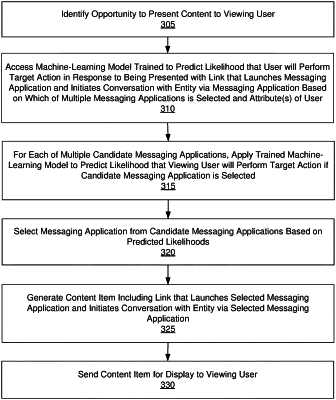| CPC G06N 20/00 (2019.01) [H04L 51/046 (2013.01); H04L 51/52 (2022.05)] | 20 Claims |

|
1. A method comprising:
identifying an opportunity to present content to a viewing user of an online system;
accessing a machine-learning model trained to predict a likelihood that a user of the online system will perform a target action in response to being presented with a link that launches a messaging application and initiates a conversation with an entity via the messaging application in which the user and the entity exchange text messages within an interface of the messaging application, wherein the likelihood is predicted based at least in part on which of a plurality of messaging applications is selected and one or more attributes of the user;
for each of a plurality of candidate messaging applications, applying the trained machine-learning model to predict the likelihood that the viewing user will perform the target action if the candidate messaging application is selected from the plurality of candidate messaging applications for inclusion in a content item;
selecting a messaging application from the plurality of candidate messaging applications for inclusion in a content item, wherein the messaging application is selected based at least in part on the predicted likelihoods;
generating a content item that comprises a link that launches the selected messaging application and initiates a conversation with the entity via the selected messaging application; and
sending the content item to a client device associated with the viewing user for presentation to the viewing user.
|